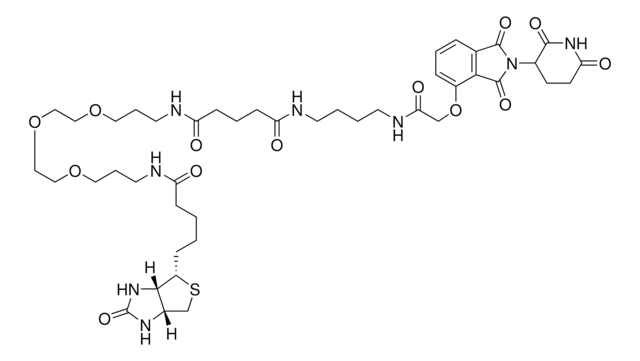914924
3-[2-N-(Biotinyl)aminoethyldithio]propanoic acid
≥95%
Synonyme(s) :
3-((2-(5-((3aS,4S,6aR)-2-Oxohexahydro-1H-thieno[3,4-d]imidazol-4-yl)pentanamido)ethyl)disulfaneyl)propanoic acid, Biotin-SS-COOH, Cleavable biotin linker
About This Item
Produits recommandés
Niveau de qualité
Pureté
≥95%
Forme
powder
Pf
172-175 °C
Température de stockage
−20°C
InChI
1S/C15H25N3O4S3/c19-12(16-6-8-25-24-7-5-13(20)21)4-2-1-3-11-14-10(9-23-11)17-15(22)18-14/h10-11,14H,1-9H2,(H,16,19)(H,20,21)(H2,17,18,22)/t10-,11-,14-/m0/s1
Clé InChI
LUKYYZVIDAWYMZ-MJVIPROJSA-N
Application
Automate your Biotin tagging with Synple Automated Synthesis Platform (SYNPLE-SC002)
Autres remarques
A Mechanism-Based ICAT Strategy for Comparing Relative Expression and Activity Levels of Glycosidases in Biological Systems
Dissociation-independent selection of high-affinity anti-hapten phage antibodies using cleavable biotin-conjugated haptens
Produit(s) apparenté(s)
Code de la classe de stockage
11 - Combustible Solids
Classe de danger pour l'eau (WGK)
WGK 3
Point d'éclair (°F)
Not applicable
Point d'éclair (°C)
Not applicable
Faites votre choix parmi les versions les plus récentes :
Certificats d'analyse (COA)
Désolés, nous n'avons pas de COA pour ce produit disponible en ligne pour le moment.
Si vous avez besoin d'assistance, veuillez contacter Service Clients
Déjà en possession de ce produit ?
Retrouvez la documentation relative aux produits que vous avez récemment achetés dans la Bibliothèque de documents.
Notre équipe de scientifiques dispose d'une expérience dans tous les secteurs de la recherche, notamment en sciences de la vie, science des matériaux, synthèse chimique, chromatographie, analyse et dans de nombreux autres domaines..
Contacter notre Service technique




![Spiro[9H-fluorene-9,9′-[9H]xanthene]-2,7-diamine](/deepweb/assets/sigmaaldrich/product/structures/307/234/46c07f0c-9242-4c0b-8994-8121690da3c9/640/46c07f0c-9242-4c0b-8994-8121690da3c9.png)


